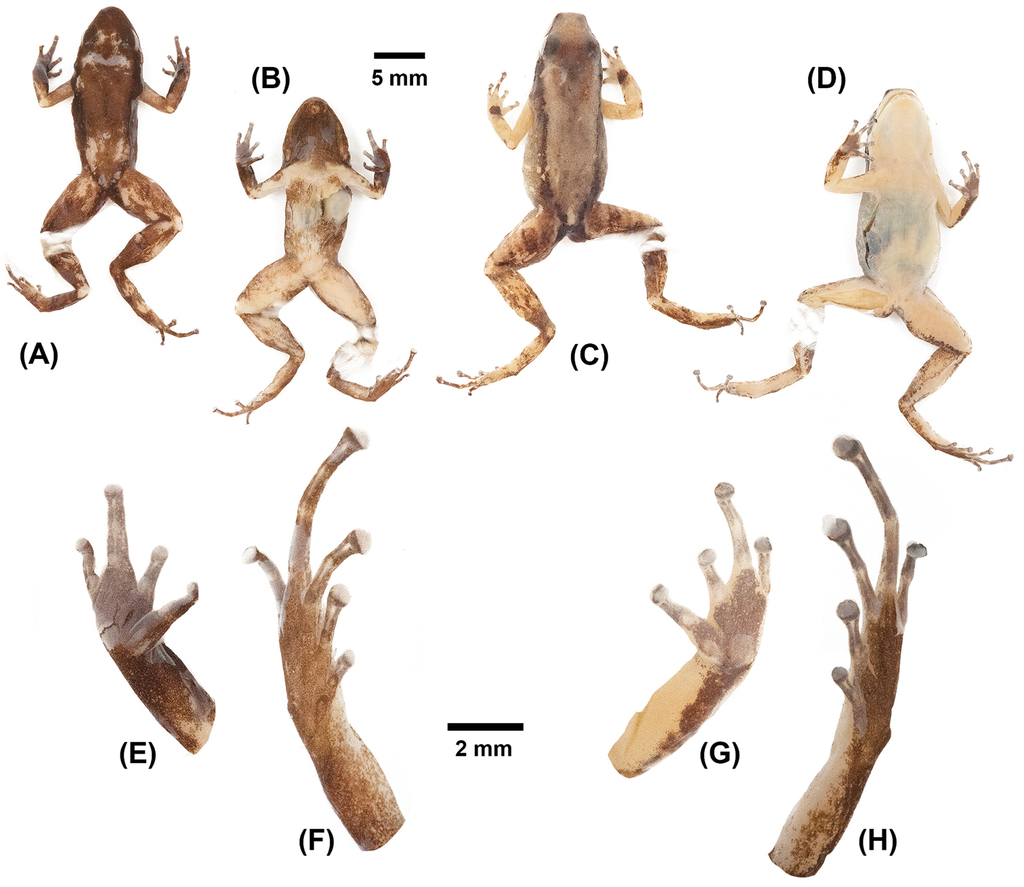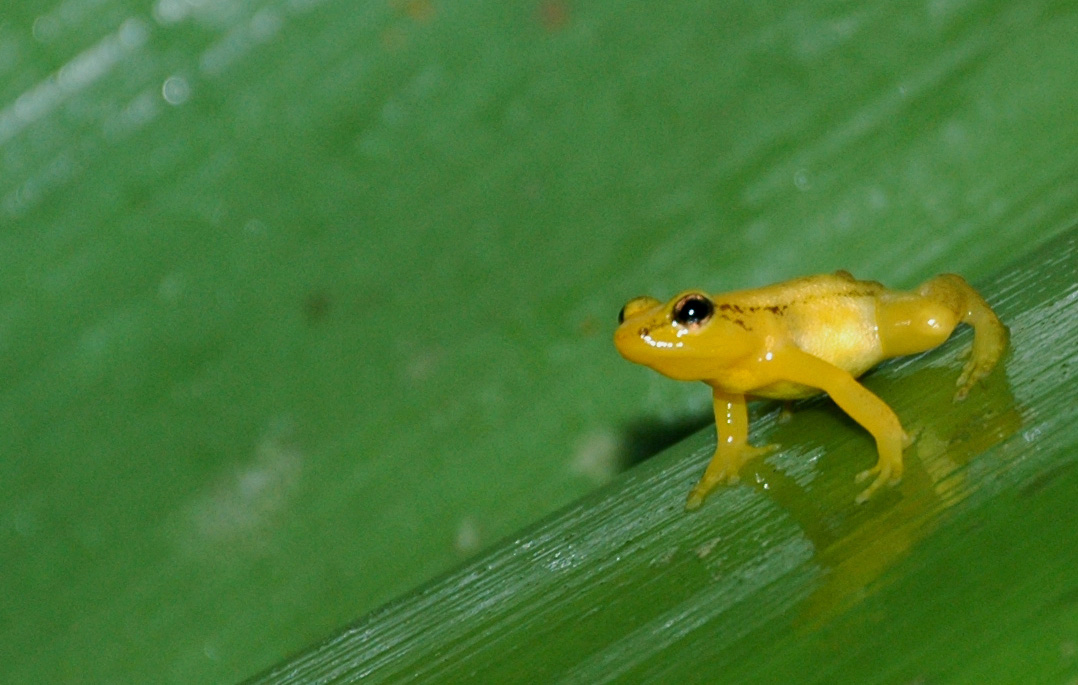- Anomaloglossus beebei: Secrets of the Tiny Golden Frog of the Tepui Highlands
- Taxonomy and Classification
- Natural Habitat: The Misty World of Tepuis
- Physical Characteristics: A Jewel on the Mountain
- Behavior and Life Cycle: Tiny Parents of Tepui Pools
- Ecological Role: Small Frog, Big Impact
- Threats and Conservation Status: Living on the Edge
- Cultural and Scientific Significance
- Conclusion: Stewarding the Golden Jewel of the Tepuis
Anomaloglossus beebei: Secrets of the Tiny Golden Frog of the Tepui Highlands#
Within isolated tabletop mountains rising abruptly from the lush jungles of South America lies a creature as mysterious as its homeland. Meet Anomaloglossus beebei, famously known as the Golden Rocket Frog. This tiny, radiant amphibian lives exclusively amidst the mist-shrouded peaks of Guyana’s Kaieteur National Park, captivating not only biologists but anyone fortunate enough to glimpse its jewel-like glow.
Though barely larger than a fingertip, this species’ fascinating behaviors, its ecological niche, and its precarious survival highlight the complex interactions between wildlife and ecosystem. Join us now, deep within cloud-covered tepui summits, as we unveil the secret life and captivating tale of Anomaloglossus beebei.
Taxonomy and Classification#
Anomaloglossus beebei belongs to the Aromobatidae family, commonly known as the aromatic poison frogs. Initially described in 1923 by renowned naturalist Charles Emerson Bee, its genus name “Anomaloglossus” references its distinctive tongue structure, which sets it apart within its family. Over time, scientists have closely analyzed its anatomy, behavior, and genetics, revealing fascinating details about its evolutionary roots and its relatives within Aromobatidae.
Closely related species within this genus often possess intricate parental behaviors and varying levels of toxicity, but A. beebei stands out not only visually but in its unique habitat reliance—a microcosmic, isolated existence atop isolated plateaus known as tepuis.
Natural Habitat: The Misty World of Tepuis#
To truly understand the golden rocket frog, we must journey to the remarkable backdrop that shapes its life. The species occurs exclusively in the bromeliad pools atop the Kaieteur Plateau in Guyana, a region famous for its dramatic waterfalls and awe-inspiring vistas. These isolated plateaus, called tepuis, tower hundreds of meters above lush South American rainforests, representing some of Earth’s oldest rock formations, some dating back nearly two billion years.
The habitat atop these tepuis comprises humid cloud forests and extensive fields of carnivorous plants and bromeliads. Bromeliads—plants capable of trapping rainwater within rosette-shaped leaf formations—provide essential breeding pools for this frog, creating isolated microhabitats where lives small yet vibrant ecosystems.
The Golden Rocket Frog thrives in this moisture-rich environment, relying entirely upon water-filled plant hollows for breeding, hunting, and safety. Adapting to the tepui lifestyle over millennia, this limited habitat has shaped the species into the ecological specialists we observe today.
Physical Characteristics: A Jewel on the Mountain#
At just around 16–19 millimeters long, Anomaloglossus beebei is extraordinarily small, but what it lacks in stature, it more than makes up for in striking appearance. Their bodies gleam in vibrant hues of gold, copper, or bright orange, making them vividly noticeable amidst verdant bromeliad leaves. This stunning coloration, striking in sparseness of the high plateau, has earned the species its popular nickname—the Golden Rocket Frog.
The frogs’ smooth, delicate skin provides more than mere ornamentation; it facilitates respiration and the exchange of necessary ions through moisture-rich surfaces. Unlike some of their poison-dart relatives, beebei frogs demonstrate significantly lower toxicity levels—a direct consequence of their specialized diet brought by their secluded environment.
This vibrant coloration, while admirably captivating to human observers, likely serves both as camouflage among golden-toned bromeliad leaves and a warning to potential predators that venturing near may not end well. This dual-purpose strategy exemplifies the intricate balance of beauty and survival strategy in the wild.
Behavior and Life Cycle: Tiny Parents of Tepui Pools#
Despite its impressive coloration, much of what fascinates breeders and herpetologists alike about the Golden Rocket Frog relates to its unique reproductive story and caregiving behaviors. Once the heavy rains envelop the tepuis, male frogs gather around bromeliad pools, releasing soft, trilling vocalizations to attract females and stake out the best-possible breeding territories.
Male Anomaloglossus beebei frogs exhibit precise territoriality, choosing carefully the fluctuating water pools of bromeliad leaves in which they await potential mates. Upon arrival of a receptive female, mating occurs swiftly, resulting in clutches of tiny eggs carefully affixed to moist surfaces within these miniature habitats.
Parental Care and Bromeliad Nurseries#
Unlike frogs that abandon their offspring after egg-laying, this species showcases remarkable parental strategies. Both sexes play vital roles, but notably, the male frequently guards the clutch, protecting it fiercely from potential predators or rival males.
Once eggs hatch, metamorphosing tadpoles remain sheltered within their aquatic leaf oasis as they develop. Here they subsist on microscopic algae, small insect larvae, and occasionally even their less-developed brethren—a harsh but natural consequence of survival in confined habitats. After several weeks, tadpoles experience wondrous metamorphosis, leaving behind their watery homes to journey among bromeliad rosettes in search of prey and eventual maturity.
Ecological Role: Small Frog, Big Impact#
While diminutive, Anomaloglossus beebei fulfills a crucial ecological role high atop these mysterious plateaus, embodying functions as both predator and prey within their sharply restricted habitat. Feeding voraciously on tiny insects such as mites, springtails, ants, and mosquito larvae, the frogs aid in controlling small insect populations, thereby stabilizing the delicate bromeliad pool ecosystems.
Conversely, their presence also supports reptiles, birds, and larger arthropods, which rely heavily upon them as energetic morsels, maintaining critical food web connections that might center on these unique frogs. In reality, each frog represents less of an individual organism and more an integral, irreplaceable gear driving tepui plateau ecology.
Threats and Conservation Status: Living on the Edge#
A limited range and narrow ecological specialization undoubtedly make the Golden Rocket Frog vulnerable. Currently, the IUCN Red List rates Anomaloglossus beebei as Vulnerable, primarily due to their extremely restricted distribution, habitat changes, climate instability, and possible introduction of disease.
Climate change represents a particular concern. Global warming brings altered precipitation patterns and erratic weather—a genuine threat for species dependent entirely on these seasonally replenished bromeliad pools. With shifts in weather patterns directly impacting the reproductive success of this fragile species, each year becomes more uncertain.
Ongoing Conservation Efforts and Future Prospects#
Fortunately, the frog’s entire known range falls within the protected Kaieteur National Park, offering some degree of legal protection and official oversight. Conservation biologists and local community members actively monitor populations, with scientists advocating continually for broader environmental protections and awareness campaigns highlighting the amphibian’s plight.
Future conservation strategies must focus not solely on monitoring, but also potentially manage breeding programs, disease prevention awareness, and conservation education—highlighting the importance of protecting even the smallest ecological treasures atop these ancient mountains.
Cultural and Scientific Significance#
Tepui ecosystems and their striking inhabitants have long fascinated indigenous cultures who attribute these elevated plateaus with sacred and mystical attributes. Local Amerindian folklore frequently reveres creatures such as these brilliant frogs, attributing spiritual wisdom or powerful symbolic messages to their presence.
Scientifically, the frog also holds significance beyond mere admiration. Understanding its life history, adaptations, and responses to environmental stressors provides critical insight into broader conservation questions facing amphibians worldwide. A sentinel species, Anomaloglossus beebei signals environmental changes taking hold of our planet.
Conclusion: Stewarding the Golden Jewel of the Tepuis#
From their radiant appearance to meticulous breeding behaviors, Golden Rocket Frogs captivate anyone lucky enough to glimpse their rare beauty. Yet, this species also reminds us of the fragile balance of life upon our ever-changing planet. Protection of Anomaloglossus beebei must serve as a clarion call: conserving Earth’s tiniest treasures ensures the overall health and vitality of vast natural systems. Let us continue to cherish, protect, and champion these golden inhabitants, thriving enchantingly upon isolated plateaus of Guyana.


















